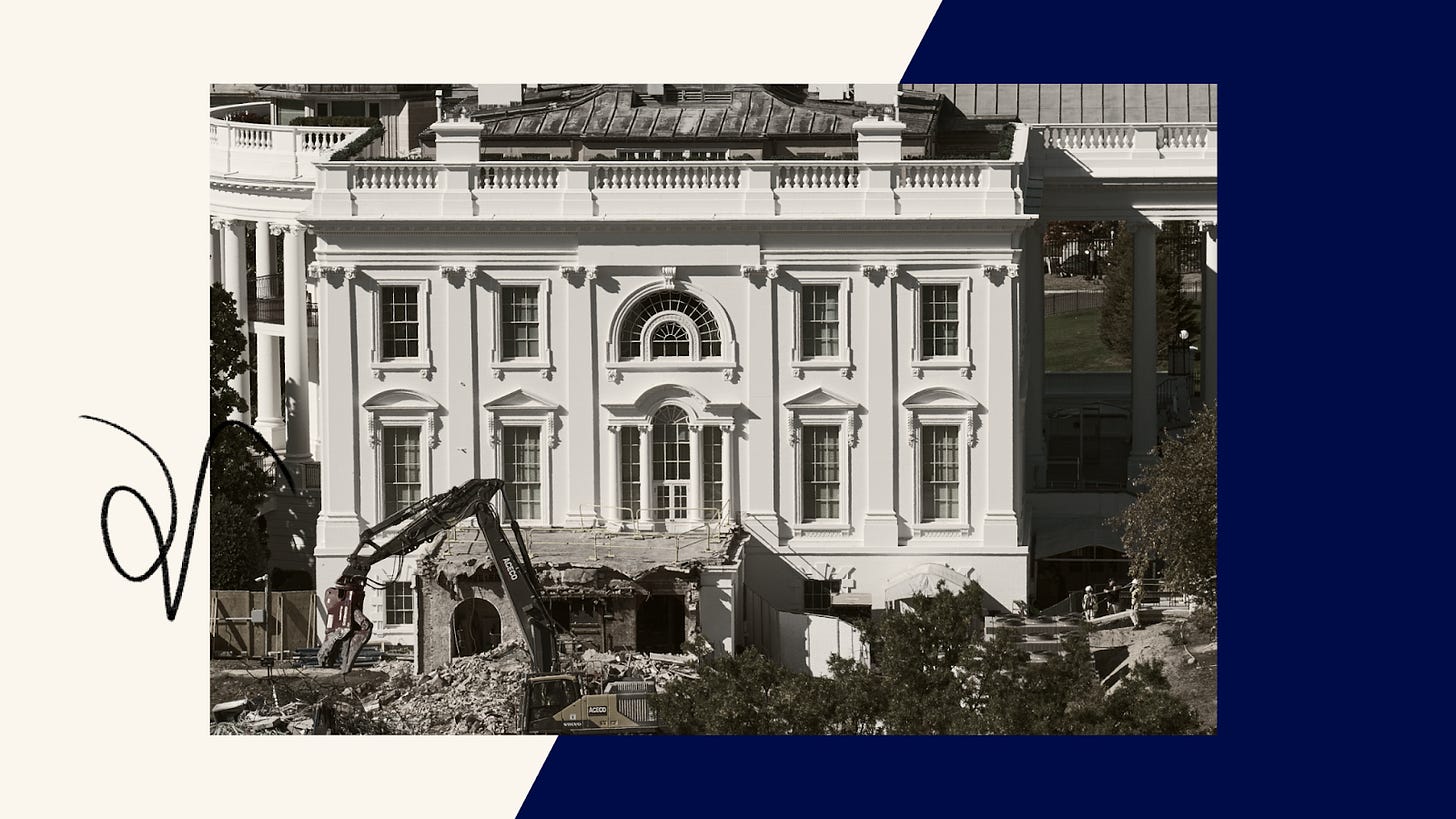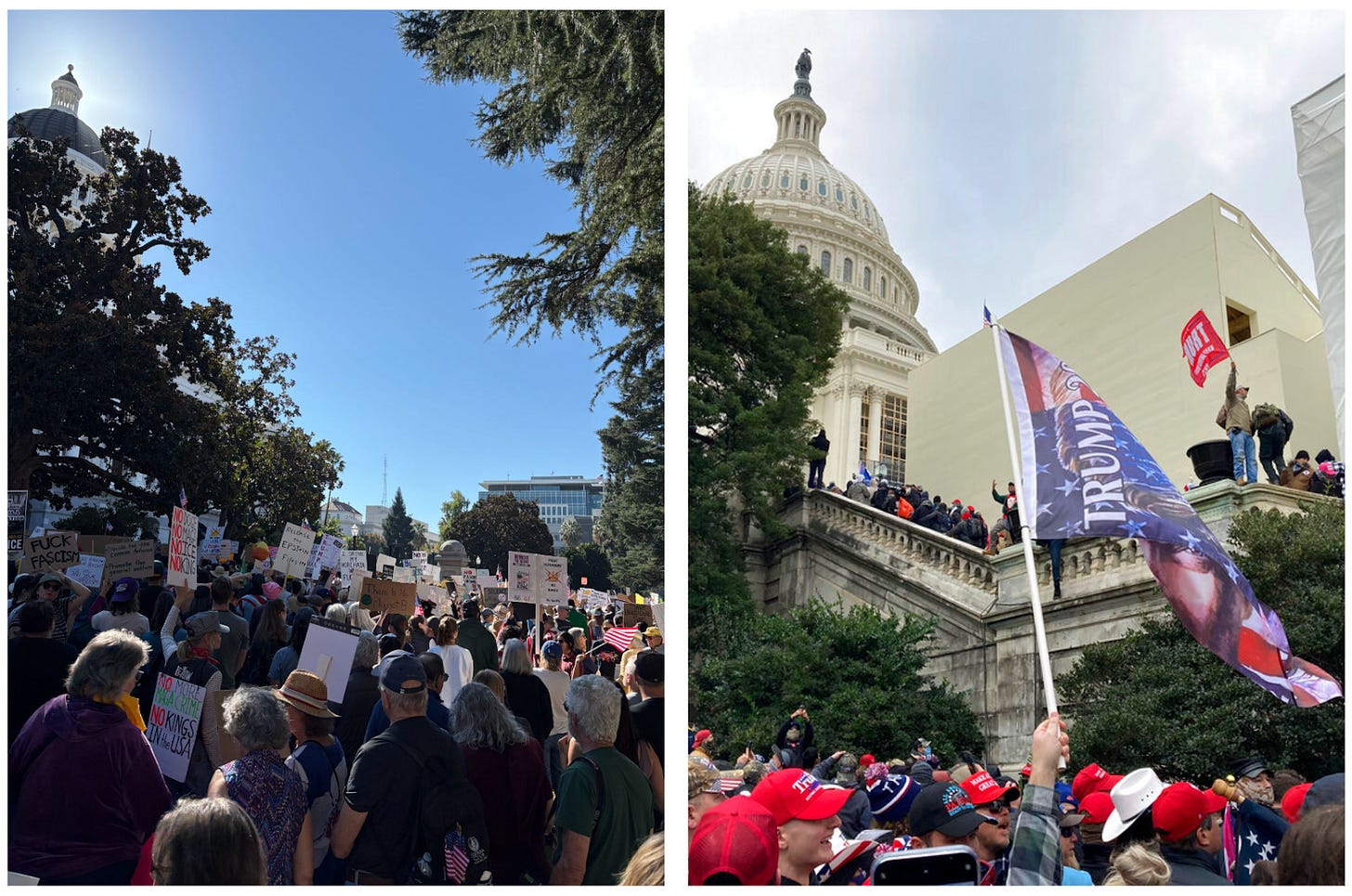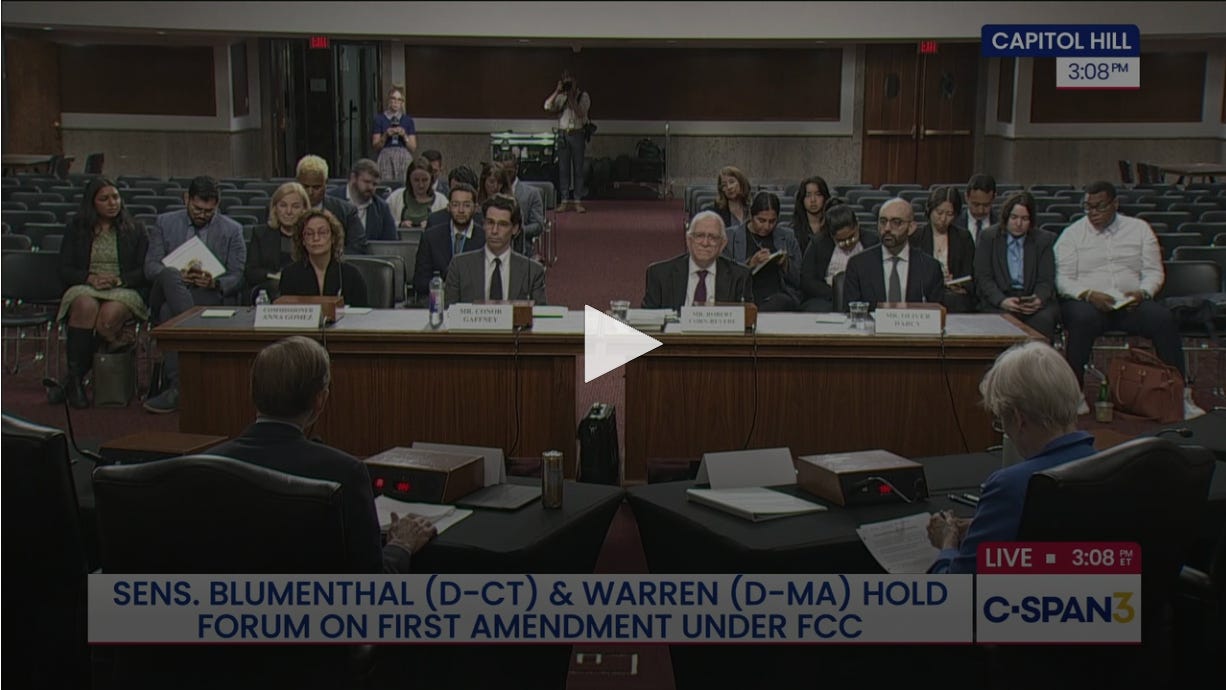
The president is tearing down a third of the White House to build a Mar-a-Lago-style ballroom. He commuted the sentence of one of the most notorious fraudsters in modern politics for — in Trump’s words — having the courage “to ALWAYS VOTE REPUBLICAN!” He pardoned a powerful cryptocurrency tycoon and key supporter of Trump family crypto enterprises. And now he’s looking to raid the U.S. Treasury of a quarter-billion dollars because he was “damaged very greatly” by “the fraud of the 2020 election.”
This sort of corruption might seem like a sideshow to an authoritarian entrenchment agenda that has profound economic and human consequences for real people.
To me, though, that’s the wrong way to think about corruption.
Corruption, across history, is practically synonymous with autocracy. Abuses of power for personal gain are both an inevitable consequence of unchecked power — that’s why the checks existed in the first place — and part of the playbook autocrats use to stay in power.
When it comes to understanding authoritarianism, the brazenness and shameless self-dealing of these sorts of scandals, none of that is a distraction from the real story. They are the story.
Both ‘enriching’ and ‘entrenching’ corruption matter
If you dissect the relationship between corruption and autocracy, it’s not really one dynamic. It’s two. There are two distinct categories of corruption: “entrenching corruption,” which is how autocrats stay in power, and “enriching corruption,” which is how they profit from doing so.
As my colleague Conor Gaffney told a congressional spotlight hearing last month:
Corruption is antithetical to democratic principles like the rule of law and public trust. However, certain kinds of corruption are also, according to political scientists, accelerants of democratic decline. Corruption that uses state resources not just to enrich public officials, but to reduce accountability, subvert institutional checks and balances, and establish a non-competitive political system undermines democratic structures and entrenches authoritarian forms of power.
To illustrate the distinction between enriching corruption and entrenching corruption, consider two kinds of corrupt practices. In Kenya, the practice of kickbacks is pervasive, where public funds are regularly siphoned by officials of many political parties and redistributed locally to supporters. In Turkey, zoning changes and non-competitive contract procurement have been used by leaders of Erdoğan’s Justice and Development party (the ruling authoritarian party) to co-opt opposition figures and parties.
Almost every day it seems we have more examples of both types. Brendan Carr’s growing FCC censorship campaign is textbook entrenching corruption — corruptly using state power to punish critics and reward Trump’s henchmen. Same with Trump’s pardon abuses (including George Santos) and extracting political concessions from law firms and universities and media companies. All of those moves seek to coerce or co-opt support to stay in power. Conversely, Trump’s billion-dollar crypto ventures and his $400 million Qatari plane (remember that?) seem mostly about enriching him personally.
Other instances arguably combine the two.
Take the president’s White House demolition job, which at face value seems analogous to the Qatari plane. He’s cajoling major corporations to build a personal vanity project, ethics rules and legal guardrails be damned.
Yes, it’s that. But the “Donald J. Trump Ballroom” is also an attempt to brazenly, permanently reshape the White House in Trump’s image. Like turning the Rose Garden into a private social club for allies and donors. Like trying to carve his own face into Mount Rushmore. Like minting his likeness onto coins.
How can that not be read as political, as fundamentally entrenching Trumpism in American politics?1
Similarly, his proposed $230 million payout from DOJ isn’t just about pocketing the money. It’s also the ultimate power grab over what was once an independent institution dedicated to upholding the rule of law. He wants to prove absolute control and show that “justice” has been entirely subverted by his whims. That the department will obey any command.
Don’t believe me?
Ask yourself this: Say Donald Trump succeeds. He successfully orders Attorney General Pam Bondi and Deputy Attorney General Todd Blanche to write him a personal check for a quarter-billion dollars of taxpayer money. What then couldn’t he order them to do?
(For the record: He’s already established that he can order politicized prosecutions by DM.)
Not to mention, this payout would make Bondi, Blanche, and presumably others at DOJ permanently complicit in potentially the largest corruption scandal in American history. Talk about incentivizing DOJ leadership to try to keep the other side from regaining power!
Corruption exposes authoritarianism for what it is: the few against the many
What’s helpful about corruption, though — odd as that sentence is to type — is that it pulls the mask off authoritarianism. There has never been anything benevolent, patriotic, or nationalistic about autocracy, here or elsewhere. At its core, this is a small group of people consolidating control over everyone else. And then using that power as they wish for their own private gain.
By focusing on the corruption — the White House demolition, the pardon abuses, the payouts, the grift, the crypto schemes, the countless other scandals — together we can help reveal the whole situation for what it is.
At some point, the obvious theft and lies push people to a boiling point that no amount of propaganda and spin and demonizing the opposition can keep a lid on.
This is what is happening right now in Serbia. As Michael Angeloni writes in this week’s Democracy Atlas: Serbia shows how backlash to corruption can swell pro-democracy movements.
Over the past eleven months, protesters have drawn links between SNS’s endemic corruption and its decade-long assault on democratic institutions and the rule of law. And unlike earlier waves of mobilization that only reached a certain segment of the public, this movement has cast a wider net by focusing on issues with which there is widespread agreement. …
[P]ensioners, farmers, veterans, state employees, and even judges have joined the hundreds of thousands rallying against corruption and advocating for a stronger democracy. Those who had been checked out of politics for years have now joined in supporting the protests. Even the state-dominated media has been forced to cover the demonstrations (much to Vučić’s dismay), reaching viewers who usually only hear the government’s talking points.
(Read the whole example. It’s a very useful one.)
Right now, we shouldn’t be thinking of American politics as left vs. right. Or even Trump vs. anti-Trump. What matters is the people in power vs. those outside of it. Like all authoritarian projects, the goal is inherently to consolidate power to the greatest degree possible.
But that means that, inadvertently, the group left out just keeps growing. Every day brings more examples of people realizing they’re on the losing side of this equation.
Exhibit A:
Two excellent new resources that can help you track and spotlight the flood of corruption:
CREW has a week-by-week tracker detailing instances of corruption and regulatory retaliation.
CAP has an ongoing tracker of “Trump’s take” — a running tabulation of the cash and gifts received by Donald Trump and his family. (As of this morning: $1,802,146,339.)
The many against the few
I gathered with about 7,000 of my neighbors on the west steps of the California state capitol for No Kings last weekend. It was a joyous, law-abiding, peaceful civic gathering with lots of kids, dogs, and grandmothers. But I couldn’t help but think about the comparison to a very different crowd five years before on the steps of a different capitol building.

The FBI estimates that between 2,000 and 2,500 people entered the U.S. Capitol on Jan. 6, 2021. That means my local No Kings protest alone inspired about three times more Americans to peacefully defend democracy than the sum total of those who violently fought to destroy it five years ago.
My local protest, per Strength in Numbers, was only the 72nd largest No Kings gathering in the country. All told, roughly seven million Americans took to the streets nationwide to peacefully and patriotically defend democracy last weekend. One in every 34 people, that’s the largest protest gathering in American history.
I’ll save you the math. That’s also more than 3,000x more Americans — Three. Thousand. Times. More. — than the ones who stormed the capitol.2
Again, I’m not talking about Trump voters or supporters generally. Most of them are fundamentally on the same side of this corruption equation; they’re also the “many,” not the “few.” And more of them seem to be agreeing with that every day.
I’m talking about the extremely small group of people who are willing to break the law, stoke (or use) violence, and generally use any means necessary to consolidate power and overturn democracy. Yes, many of those people are in positions of power, but they remain a tiny minority.
And if their reactions to No Kings is any indication — calling millions of their fellow Americans “terrorists” and posting videos of dropping literal feces on American cities — I’d say they know it, too.
There are more of us than there are of them. We are going to win.
What else we’re tracking:
A new primer for nonprofit organizations: What if your organization receives a demand to disclose sensitive data?
My bosses were afraid of crossing Trump. So, I quit. Veteran journalist Alan Greenblatt explains how pernicious self-censorship is infecting the media.
Trump has — for now — called off a planned federal law enforcement “surge” in San Francisco.
A protester in Washington, D.C., was arrested for playing Star Wars’ “Imperial March” behind National Guard troops walking through Logan Circle.
Curious who is funding the Donald J. Trump Ballroom? NBC has the list.
How you can help:
Here’s Anna Dorman’s tip of the week:
We are a little under 2 weeks away from more than 180 critical elections all across the country — including gubernatorial races in New Jersey and Virginia, judicial races in Pennsylvania, and crucial referenda on a huge range of issues across the country.
Visit Vote 411 to check your registration and see what’s on the ballot in your community. Then make a plan to vote and check in with at least 3 other people to make sure they have a plan as well.
BONUS: It’s not too late to sign up to be a poll worker!
Keep acting like a majority. See you next week.
A small but important rejoinder to the White House’s claim that, essentially, “other presidents did this kind of thing too.” First, no they didn’t — most of the big legacy stuff, the coins and Mt. Rushmore and so on, was all retrospective and (generally by law) posthumous. Second, the ones who reshaped the White House mainly did so as a side effect of transformational presidencies. You see lots of FDR in the White House floor plan because he was president through World War II. Not because he used the floor plan as a propaganda tool.
The size discrepancy holds even by the far more conservative comparison with the larger pre-insurrection Jan. 6 rally. That was about 50,000 people in front of White House — most of whom peacefully exercised their constitutional rights, abhorrent as their election denial may have been, and then went home without going to the Capitol or breaking any laws. No Kings was approximately 140 times larger.




Follow Trump’s grift in White House demolition and pardoning a convicted Bitcoin billionaire
https://thedemlabs.org/2025/10/24/follow-trumps-grift-in-white-house-demolition-and-pardoning-a-convicted-bitcoin-billionaire/
See who Trump has pardoned with this free app: Pardons Pedophiles, Insurrectionists and Grifters
https://thedemlabs.org/2025/10/19/trump-pardons-pedophiles-insurrectionists-grifters/
Thanks for including a link to the nonprofit data demand primer. Really helpful!